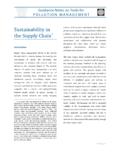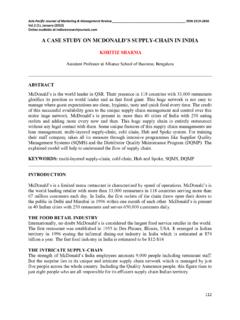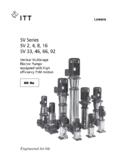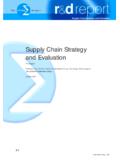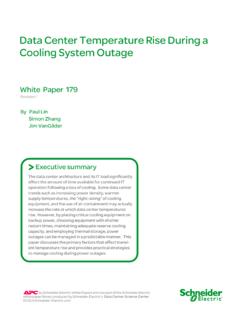Transcription of 4 Water safety plans - WHO
1 48 The most effective means of consistently ensuring the safety of a drinking-watersupply is through the use of a comprehensive risk assessment and risk manage -ment approach that encompasses all steps in Water supply from catchment to con-sumer. In these Guidelines, such approaches are termed Water safety plans (WSPs).The WSP approach has been developed to organize and systematize a long history ofmanagement practices applied to drinking- Water and to ensure the applicability ofthese practices to the management of drinking- Water quality. It draws on many of theprinciples and concepts from other risk management approaches, in particular themultiple-barrier approach and HACCP (as used in the food industry).
2 This chapter focuses on the principles of WSPs and is not a comprehensive guideto the application of these practices. Further information on how to develop a WSPis available in the supporting document Water safety plans (section ).Some elements of a WSP will often be implemented as part of a drinking-watersupplier s usual practice or as part of benchmarked good practice without consolida-tion into a comprehensive WSP. This may include quality assurance systems ( , ISO9001:2000). Existing good management practices provide a suitable platform for inte-grating WSP principles. However, existing practices may not include system-tailoredhazard identification and risk assessment as a starting point for system can vary in complexity, as appropriate for the situation.
3 In many cases, theywill be quite simple, focusing on the key hazards identified for the specific wide range of examples of control measures given in the following text does notimply that all of these are appropriate in all cases. WSPs are a powerful tool for thedrinking- Water supplier to manage the supply safely. They also assist surveillance bypublic health should, by preference, be developed for individual drinking- Water , for small systems, this may not be realistic, and either specified technologyWSPs or model WSPs with guides for their development are prepared. For smallersystems, the WSP is likely to be developed by a statutory body or accredited third-party organization.
4 In these settings, guidance on household Water storage, handlingand use may also be required. plans dealing with household Water should be linked4 Water safety plans4. Water safety PLANS49to a hygiene education programme andadvice to households in maintainingwater WSP has three key components,which are guided by health-based targets(see chapter 3) and overseen throughdrinking- Water supply surveillance (seechapter 5). They are: system assessmentto determinewhether the drinking- Water supply chain (up to the point of consumption) asa whole can deliver Water of a quality that meets health-based targets.
5 This alsoincludes the assessment of design criteria of new systems; identifying control measures in a drinking- Water system that will collectivelycontrol identified risks and ensure that the health-based targets are met. For eachcontrol measure identified, an appropriate means ofoperational monitoringshould be defined that will ensure that any deviation from required perform-ance is rapidly detected in a timely manner; and managementplans describing actions to be taken during normal operation or incident conditions and documenting the system assessment (including upgradeand improvement), monitoring and communication plans and supporting primary objectives of a WSP in ensuring good drinking- Water supply practice arethe minimization of contamination of source waters, the reduction or removal of con-tamination through treatment processes and the prevention of contamination duringstorage, distribution and handling of drinking- Water .
6 These objectives are equallyapplicable to large piped drinking- Water supplies, small community supplies andhousehold systems and are achieved through: development of an understanding of the specific system and its capability tosupply Water that meets health-based targets; identification of potential sources of contamination and how they can be controlled; validation of control measures employed to control hazards; implementation of a system for monitoring the control measures within thewater system; timely corrective actions to ensure that safe Water is consistently supplied.
7 And undertaking verification of drinking- Water quality to ensure that the WSP isbeing implemented correctly and is achieving the performance required to meetrelevant national, regional and local Water quality standards or the WSP to be relied on for controlling the hazards and hazardous events forwhich it was set in place, it needs to be supported by accurate and reliable technicalA WSP comprises, as a minimum, the threeessential actions that are the responsibil-ity of the drinking- Water supplier in orderto ensure that drinking- Water is are: a system assessment; effective operational monitoring; and FOR DRINKING- Water QUALITY50information.
8 This process of obtaining evidence that the WSP is effective is known asvalidation. Such information could be obtained from relevant industry bodies, frompartnering and benchmarking with larger authorities (to optimize resource sharing),from scientific and technical literature and from expert judgement. Assumptions andmanufacturer specifications for each piece of equipment and each barrier need to bevalidated for each system being studied to ensure that the equipment or barrier iseffective in that system. System-specific validation is essential, as variabilities in waterFigure Overview of the key steps in developing a Water safety plan (WSP)4.
9 Water safety PLANS51composition, for instance, may have a large impact on the efficacy of certain normally includes more extensive and intensive monitoring thanroutine operational monitoring, in order to determine whether system units are performing as assumed in the system assessment. This process often leads to improvements in operating performance through the identification of the most effec-tive and robust operating modes. Additional benefits of the validation process mayinclude identification of more suitable operational monitoring parameters for of drinking- Water quality provides an indication of the overall per-formance of the drinking- Water system and the ultimate quality of drinking-waterbeing supplied to consumers.
10 This incorporates monitoring of drinking- Water qualityas well as assessment of consumer a defined entity is responsible for a drinking- Water supply , its responsibil-ity should include the preparation and implementation of a WSP. This plan shouldnormally be reviewed and agreed upon with the authority responsible for protectionof public health to ensure that it will deliver Water of a quality consistent with thehealth-based there is no formal service provider, the competent national or regionalauthority should act as a source of information and guidance on the adequacy ofappropriate management of community and individual drinking- Water supplies.










